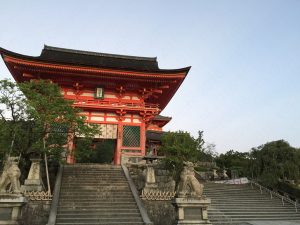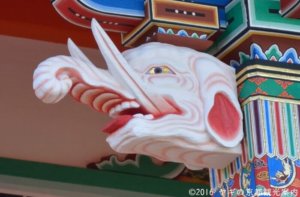THE GIST OF THIS ARTICLE
- Page 1 Introduction, History, Renovation, Deities
- Page 2 Main hall, Stage
- Page 3 Umatodome, Komainus, Niomon Gate, Saimon Gate
- Page 4 Tiger in lantern, Sho Roh and bell, Zuigu Doh temple, Kagekiyo Tsumegata Kannon
- Page 5 Pagoda, Kyo Doh, Tamra Doh, Todoroki Mon gate
- Page 6 Asakura Doh, Bussoku Seki, Iron canes and sandals, Scars of Benkei
- Page 7 Jishu shrine, Shaka Doh, Amida Doh, Oku no In, Koyasu pagoda
- Page 8 Access to Kiyomizudera
The following is the contents of this article.
Uma Todome 馬駐
Uma Todome is located at the entrance of Kiyomizudera, in front of Niomon gate. It is a parkind place for horses. It escaped from the fire in 1629.

No one can enter Shinto shrine or Buddhist temple but Kuze Komagata Chigo of Gion Matsuri is an exception. He is considered as a deity.
Next to it, there used to be parking lots for Gissha.
There are rings for reins. The one is in the red circle is installed in a different angles from the others.
Koma Inus 狛犬

The Seven Wonder #1
In front of Niomon gate, there are two statues of Komainus. Komainu is guardian of Shinto shrine. These Komainu are guardians of Jisyu shrine, not of Kiyomizu-dera.
Usually, the right one opens mouth. It is called “Agyo” which means the beginning of the world. On the other hand, the left one shuts its mouth. It is called “Ungyo” which means the end of the world. By Agyo and Ungyo, a pair of Komainu represents the universe.
The peculiar thing about Komainu of Koiyomizu-dera is that both of them open their mouth. No one knows the exact reason. Some says that they ask visitors to pray with smile because Kiyomizu-dera is at the end of a steep slope and many visitors are tired at the gate.

Actually, they are in the form of Koma Inu, before Mikkyo (Vajrayama Buddhism) was introduced.

The ones in Kurmazaki Shrine also opens their mouth.
Nio mon 仁王門
This is the main gate of Kiyomizu-dera temple. It was renovated in 2003. West gate used be the main gate.
(The view from Saimon, west gate. The gate is Niomon.)
Some says naively, “Without Niomon, people looked down the Imperial Place at the west gate. To avoid it, Niomon was constructed as the main gate.” but it is not the truth. Niomon is only located at the entrance.
We can see lattice windows on the both side of the gate. There are statues of Nio inside. Nio is the Buddhist deity who saves the Buddhism and its believers. The gate is named after them. These statues work as guardians of Kiyomizu-dera temple. (The photo above is taken at Ninnnaji temple.)
い。
On the curtain of the gate, Shika deers are dyed. There is a story about them. When Sakanoue no Tamuramao buried Shika deers wholeheartedly, many Shika deer a appeared out of nowhere to prepare for the foundation of the main hall.
The small hill behind the gate is believed the grave yard of the deer.

I guess it is an ancient tomb or something.

Seven wonder #2
Put your ear to the dimple. When someone knock that of the other side, you can hear pleasant sound.
West gate 西門
It used be the main gate as indicated before. Today, we cannot pass through it. The original one was build in the 13th century. The one we find today was build in 17th century.
In Seiryue, the dragon passes through the gate.
It doesn’t work as a gate but we can admire a good view there. At twilight, the view reminds us of Gokurakujodo, or the Western Paradise. Actually, it is a place for a practice called Nissokan. Nissokan is a training in Amitayurdhyana Sutra. Monks tries to find the paradise in twilight.
If you were interested in the Western Paradise, read an article below.

Come and see ME!
At the gate, there are Bakus. Baku is an imaginary creature that devour nightmare and get rid of evil things. We can find it at Shinto shrines and Buddhist temple.
Architectures in Buddhist temple was painted in Gokusaishiki color usually. Unfortunately, many temple cannot afford to re-paint them and we seldom see beautiful ones. Kiyomizu-dera is one of the ecceptions. DO NOT forget binoculars or something. We are not allowed to get close to the gate.




















